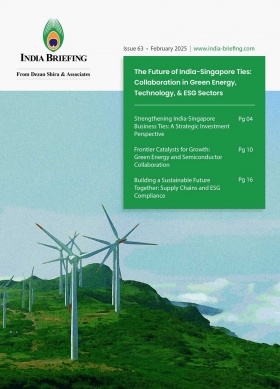India’s Climate Finance Taxonomy in 2025: An Overview
India is advancing its green finance strategy with the rollout of a Draft Climate Finance Taxonomy, aiming to align investments with its net zero 2070 target. The taxonomy provides a structured framework to guide capital toward credible climate solutions while preventing greenwashing.
With rising mitigation and adaptation flows, growing private sector participation, and stronger regulatory support, the evolving green finance landscape presents new opportunities for businesses, investors, and MSMEs across sectors like clean energy, transport, and agriculture.
India has pledged to achieve Net Zero emissions by 2070 and meet its updated Nationally Determined Contributions (NDCs) by 2030. These include reducing the emissions intensity of its GDP and expanding non-fossil fuel energy, meeting these goals will demand an estimated US$2.5 trillion in climate finance.
To accelerate progress, India unveiled a Draft Climate Finance Taxonomy in the Union Budget FY 2024–25. Developed by the Department of Economic Affairs, this taxonomy lays out criteria for identifying climate-relevant activities and channels capital into low-carbon sectors. It also aims to prevent greenwashing by providing a common, science-based framework for public and private stakeholders.
The taxonomy outlines both mitigation and adaptation priorities, promote indigenous innovation, and offers a structured approach to financing hard-to-abate sectors. By aligning financial flows with national climate goals, the taxonomy is expected to unlock investments opportunities and expand scope for businesses across clean energy, transport, real estate, and agriculture sector.
The NDCs is India’s climate action commitments under the Paris Agreement. In its updated submission in 2022, India pledged to reduce the emissions intensity of its GDP by 45 percent from 2005 levels by the year 2030. It also committed to sourcing 50 percent of its total installed electric power capacity from non-fossil fuel-based energy sources, including solar, wind, hydro, and nuclear.
India’s draft climate finance taxonomy: Blueprint for green investment
The draft climate finance taxonomy sets four core objectives:
- Support climate mitigation,
- Strengthen adaptation capacity,
- Enable the transition of hard-to-abate sectors, and
- Prevent greenwashing.
The framework follows principles to ensure credibility and impact. It aims to unlock capital, support innovation, and align investment with India’s Net Zero pathway—creating clear opportunities across clean energy, transport, real estate, and agriculture.
Under the implementation blueprint, India will apply qualitative criteria to broadly define climate-aligned activities. Over time, the taxonomy will adopt quantitative thresholds—for example, specific emissions savings—to bring more precision and accountability to climate finance classification. The taxonomy classifies activities into two main categories:
- Climate-supportive activities: These include projects that reduce emissions, deploy adaptation solutions, or contribute to climate goals through research and innovation.
- Tier 1 includes activities that directly avoid emissions, such as renewable energy.
- Tier 2 includes those that lower emissions intensity with clear pathways for improvement.
- Climate transition activities: These refer to projects in sectors where low-emission alternatives are not yet viable. The taxonomy provides a pathway for these sectors to decarbonize over time without disrupting their economic function.
This structure aims to direct public and private investment toward credible, measurable, and impactful climate solutions across India’s economy.
Sectoral landscape in 2024: Leading green finance flows
In FY 2021-22, India’s green finance reached INR 3.7 trillion (approximately US$50 billion), marking a 20 percent increase from FY 2019-20. This growth reflects stronger investment in clean technologies and the government’s expanding support for low-carbon development.
Among mitigation sectors:
- Clean energy accounted for the largest share, drawing 47 percent of tracked finance.
- Energy efficiency followed with 35 percent, targeting industrial upgrades and building retrofits.
- Clean transportation, including electric mobility and infrastructure, captured the remaining 18 percent.
Adaptation finance has also seen significant progress, nearly tripling since FY 2019/20. Most of this capital (98 percent) comes from domestic sources, with multilateral development banks contributing a small but growing share. Key focus areas include:
- Disaster risk management (42 percent of adaptation flows),
- Flood and cyclone mitigation (32 percent), and
- On-farm adaptation in agriculture (24 percent), signaling increased attention to climate-resilient farming.
The taxonomy identifies power, mobility, and buildings as priority sectors for both mitigation and adaptation benefits. These sectors are central to India’s energy transition, urban development, and emissions reduction strategy.
Agriculture, which contributes 16 percent to GDP and employs over 46 percent of the workforce, is another critical area. Its high exposure to climate risks and its importance to rural livelihoods make it a key target for adaptation finance. Investment in resilient infrastructure, irrigation, and sustainable farming practices is expected to rise under the taxonomy’s guidance.
These sectoral shifts indicate growing alignment between capital flows and India’s climate goals, with significant opportunities for public-private collaboration and technology deployment.
Key stakeholders and enabling ecosystem
India’s green finance ecosystem is supported by a mix of public institutions, private sector leadership, and a growing set of financial instruments and regulatory frameworks.
Public institutions role in policy framework
The Reserve Bank of India (RBI) has introduced a sovereign green bond framework, green deposits, and priority lending norms to encourage sustainable investment. Meanwhile, the Securities and Exchange Board of India (SEBI) has expanded its oversight through ESG fund regulation and mandatory reporting under the Business Responsibility and Sustainability Reporting (BRSR) framework.
Green lending is also led by key public financial institutions:
- Indian Renewable Energy Development Agency (IREDA),
- Power Finance Corporation (PFC), and
- National Bank for Agriculture and Rural Development (NABARD),
which channel significant funding to renewable energy, rural infrastructure, and clean technology projects.
Private sector driving capital and innovation
Private firms in the country are well-positioned to leverage the taxonomy, particularly in sectors such as green mobility and construction. Engineering, procurement, and construction (EPC) firms, clean tech developers, and fintech platforms are actively driving innovation in project execution, financing models, and risk-sharing mechanisms.
Expanding financial instruments
India’s green finance market continues to diversify. Key instruments include the following:
- Sovereign and corporate green bonds,
- ESG-themed mutual funds,
- Priority sector lending to green segments,
- Production Linked Incentive (PLI) schemes for clean manufacturing, and
- FAME subsidies supporting the adoption of electric vehicles.
These tools help reduce financing costs and support scale-up of sustainable infrastructure.
Ensuring credibility and market confidence
Indian regulators have tightened disclosure requirements and broadened definitions to ensure consistency and reduce greenwashing:
- SEBI’s Green Debt Guidelines standardize green bond issuance and monitoring.
- The RBI’s inclusion of green activities under Priority Sector Lending (PSL) ensures wider credit access.
- The BRSR framework now applies to India’s top 1,000 listed companies, mandating sustainability reporting and ESG integration.
Together, these institutional, financial, and regulatory pillars are building a more mature, transparent, and scalable green finance market in India.
Enablers and barriers to green finance growth
India’s green finance framework presents a strong foundation, but its success depends on how effectively the country leverages key enablers while addressing structural barriers. One of the most important enablers is technological innovation. Rapid progress in solar photovoltaics, electric vehicles, bioenergy, and small modular reactors is creating new investment pathways. Government programs like the PLI schemes and FAME subsidies have further supported domestic manufacturing and technology adoption.
Regulatory clarity is improving through measures such as SEBI’s ESG standards and improved disclosure norms, which support investor confidence and reduce greenwashing. However, several challenges continue to exist. Fragmentation across legal, financial, and regulatory systems creates inefficiencies and delays capital deployment. Inconsistent criteria across institutions often complicate compliance and limit private sector participation. Data availability is another critical issue. Many sectors—particularly agriculture and MSMEs—lack reliable, real-time emissions or performance data, making it difficult to apply quantitative thresholds or assess outcomes.
Additionally, the current taxonomy presents some ambiguity in classifying Tier 2 and transition activities, which can lead to confusion about eligibility. Finally, India needs stronger mechanisms to attract international climate finance. While domestic funding dominates, scaling green investment will require improved access to foreign direct investment, development assistance, and blended finance models. Addressing these gaps is essential to realizing India’s long-term climate finance goals.
Implications for businesses and investors
The Draft Climate Finance Taxonomy offers meaningful opportunities for businesses and investors across sectors. For companies, especially those in green construction, mobility, agri-tech, and renewable energy, the framework opens up new avenues for climate-aligned investment in India. By clearly defining eligible activities, the taxonomy helps businesses tap into green finance more effectively. It also improves access to subsidized loans, government-backed certification, and streamlined approvals, especially for projects that fall under Tier 1 or transition categories.
For investors, the taxonomy provides a much-needed structure to assess risk, measure impact, and align portfolios with ESG principles. It brings greater clarity and transparency to the market, making it easier to identify projects that meet credible climate criteria. Over time, taxonomy-aligned projects may receive preferential treatment from lenders, regulators, or incentive programs, helping investors unlock more stable, long-term returns.
About Us
India Briefing is one of five regional publications under the Asia Briefing brand. It is supported by Dezan Shira & Associates, a pan-Asia, multi-disciplinary professional services firm that assists foreign investors throughout Asia, including through offices in Delhi, Mumbai, and Bengaluru in India. Dezan Shira & Associates also maintains offices or has alliance partners assisting foreign investors in China, Hong Kong SAR, Vietnam, Indonesia, Singapore, Malaysia, Mongolia, Dubai (UAE), Japan, South Korea, Nepal, The Philippines, Sri Lanka, Thailand, Italy, Germany, Bangladesh, Australia, United States, and United Kingdom and Ireland.
For a complimentary subscription to India Briefing’s content products, please click here. For support with establishing a business in India or for assistance in analyzing and entering markets, please contact the firm at india@dezshira.com or visit our website at www.dezshira.com.
- Previous Article US Appeals Court Reinstates Trump Tariffs: Key Updates for India
- Next Article Navigating Venture Capital Investment Trends in India








